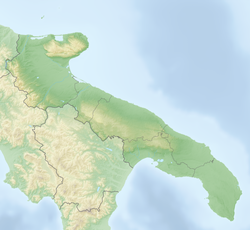| San Giovanni Rotondo Formation | |
|---|---|
| Stratigraphic range: Hauterivian-Barremian ~ | |
| Type | Geological formation |
| Lithology | |
| Primary | Limestone |
| Other | Claystone |
| Location | |
| Coordinates | 41°42′N15°42′E / 41.7°N 15.7°E |
| Approximate paleocoordinates | 26°06′N19°42′E / 26.1°N 19.7°E |
| Region | Apulia |
| Country | Italy |
The San Giovanni Rotondo Formation is an Early Cretaceous (Hauterivian to Barremian) geologic formation in Italy. Fossil ornithopod tracks have been reported from the formation. [1]

